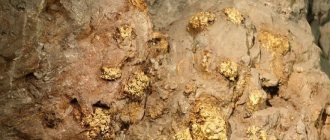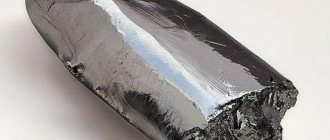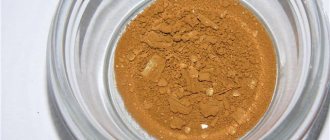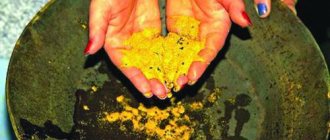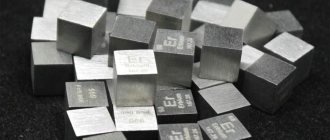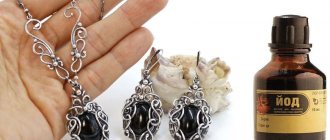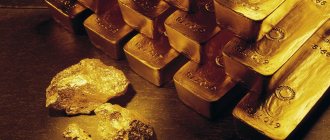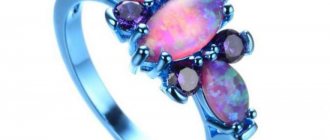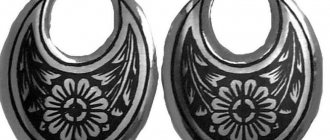Post updated: May 26, 2020
Gold, along with silver and six other platinum group metals, are called noble, or precious, metals. What do these definitions mean? Gold is very reluctant to combine with chemical elements that are not metals. The simplest example is interaction with oxygen: after all, base metals in this case are oxidized, but gold retains its appearance and structure. It is for these qualities that the yellow metal received the definition of “noble”. The rarity of gold in nature, its durability and beauty have allowed it to also receive the status of a precious metal. What are the main properties of gold?
What is it like
Gold is part of a separate group of precious metals.
Who knows, despising the mob and slaves, arrogant gold “does not want” to come into contact (chemical reactions) with other elements. It has always been precious - the beauty, brilliance, and durability of the metal were reserved for aristocrats and other favorites of fate.
Chemical and physical properties:
- Pure gold has a very low hardness - 2.5-3. Anyone who has read books about history remembers that gold coins were often “tested.” Real coins left teeth marks, but fake ones (with a large amount of impurities, usually copper) did not.
- Gold melts at a temperature of 1064°C; If you heat it to 2947 °C, it will begin to boil and evaporate.
- The specific gravity of the metal is 19.3 g/cm3. A kilogram of gold will easily fit in a pocket or handbag - it can be easily “packed” into a cube with a side of 3.7 cm.
- The malleability of the metal is amazing. Just one gram can be rolled into a sheet with an area of half a square meter. This is "gold leaf".
- For the production of jewelry, gold has another attractive property. The metal is very flexible and malleable, which means it bends and stretches easily.
- The crystal structure of the metal lattice is cubic, face-centered.
- Chemically, the metal is very inert. Under normal conditions it does not want to react with other elements. The exception is mercury.
- The solar metal can be dissolved in “aqua regia” (a mixture of nitric and hydrochloric acids in a ratio of 1:3). Slowly, but reacts with cyanide, potassium iodide, liquid bromine.
Please note: your gold jewelry should be protected from iodine, mercury, and chlorine.
| Name, symbol, number | Gold / Aurum (Au), 79 |
| Atomic mass (molar mass) | 196.966569(4)[1] a. e.m. (g/mol) |
| Electronic configuration | [Xe] 4f14 5d10 6s1 |
| Atomic radius | 144 pm |
| Chemical properties | |
| Covalent radius | 134 pm |
| Ion radius | (−3e) 185 (+1e) 137 pm |
| Electronegativity | 2.64 (Pauling scale) |
| Electrode potential | Au←Au3+ 1.50 V, Au←Au+ 1.70 V |
| Oxidation states | −1,1,3,5 |
| Ionization energy (first electron) | 889.3 (9.22) kJ/mol (eV) |
| Thermodynamic properties of a simple substance | |
| Density (at normal conditions) | 19.3-19.32[2][3] g/cm³ |
| Melting temperature | 1337.33 K (1064.18 °C, 1947.52 °F)[2] |
| Boiling temperature | 3129 K (2856 °C, 5173 °F)[2] |
| Ud. heat of fusion | 12.68 kJ/mol |
| Ud. heat of vaporization | ~340 kJ/mol |
| Molar heat capacity | 25.39[4] J/(K mol) |
| Molar volume | 10.2 cm³/mol |
| Crystal lattice of a simple substance | |
| Lattice structure | cubic face-centered Cu type, space group Fm3m |
| Lattice parameters | 4.0781 Å |
| c/a ratio | 1 |
| Debye temperature | 170.00 K |
| Other characteristics | |
| Thermal conductivity | (300 K) 318 W/(m K) |
| CAS number | 7440-57-5 |
We recommend: ANTIMONY - from eye beauty to batteries
The largest gold mining companies in Russia
The results of 2022 ranked the leading Russian gold miners in the following order:
- 1st place – PJSC Polyus.
- 2nd place – Polymetal Group of Companies.
- 3rd place – KinrossGold.
- 4th place – Petropavlovsk Group of Companies.
- 5th place – Nordgold Group of Companies.
- 6th place – JSC Yuzhuralzoloto GC.
- 7th place – HighlandGold.
- 8th place – PJSC “Vysochaishy” (GV Gold).
- 9th place – JSC “Pavlik”.
- 10th place – PJSC Seligdar.
- 11th place – PJSC Susumanzoloto.
- 12th place – GRK Bystrinskoye (Norilsk Nickel).
- 13th place – JSC “Gold of Kamchatka”.
- 14th place – JSC “Priisk Solovyovsky”.
- 15th place – Sibzoloto Holding.
- 16th place – JSC GRK “Zapadnaya”.
- 17th place – Arbat Concern.
- 18th place – “Artel of Prospectors Vitim”.
- 19th place – JSC Okhotsk Mining and Gas Concentrating Company.
Deposits and their classification
The origin of our precious metal in deposits depends on the type of rock:
- Gold-quartz formations. Confined to fault zones. The metal distribution is uneven; enriched areas called “bonans” or “ore pillars” are formed.
- Deposits of gold-polysulfide-quartz formation. They are confined to granitoid and subvolcanic complexes. Average metal content is 10-15 g/t.
- Gold-larchite deposits. These include the Khaak-Sairskoye (Tuva), Mechnikovskoye, Kirovskoye (Ural) fields.
- Gold-sulfide deposits. Associated with volcanic-sedimentary strata.
- Porphyry gold deposits. This type includes the Bereznyakovskoye (Ural), Yubileinoye (Kazakhstan), Kyzyk-Chadr (Tuva) deposits.
- Deposits of oxidation zones. They are confined to the upper horizons of sulfide deposits in many sulfide deposits.
- Placer deposits often accompany primary gold fields. The length of placers is from 200-300 meters, less often 3-5 km. The width of the placers is 20-30 meters, less often - 100-300 meters. According to the conditions of occurrence, there are placers associated with river beds, floodplains, terraces, valleys, and intermountain depressions.
The world's largest gold deposit is located in South Africa. According to some reports, up to half of the world's production is obtained here.
Is there a lot of gold on Earth?
Many analysts believe that reserves of the mined “despicable metal” are difficult to calculate.
Experts give figures that vary by orders of magnitude (from 155,000 tons to 2.5 million tons).
There are countries where illegal gold mining is thriving, while other states prefer to keep production volumes secret. The principle “don’t count my money” works both for individual citizens and at the state level.
Metal mining from ancient times to the present day
Gold is an amazing metal. All minerals are mined to be used and consumed, but they are mostly hoarded. States and individual citizens.
From Egypt to America
It is believed that the Egyptians were the first to mine the yellow metal. Chronicles recorded metal mining in the Arabian-Nubian province. There were rich deposits there. Even in the time of Thutmose III, about 50 tons of gold were mined there per year. And in total, during its operation, the deposit produced more than 3,500 tons of metal.
However, the deposit has become depleted. Many historians associate the decline of Egypt precisely with the fall in the amount of precious metal in the state.
New deposits have been found in Europe (Spain, Austria-Hungary). And with the Spanish conquests in America, solar metal poured into the Old World in a torrent.
Over the entire history of mankind, about 167,000 tons of the precious metal have been mined.
Of these, 12% were used in industry, and of 50% people made jewelry.
In any case, the extraction of precious metals stimulated the development of metallurgy, and at the same time international trade.
Modern gold mining
The days of the gold rush that shook countries are long gone. Cruel romance, when thousands of people went bankrupt and many died, is a thing of the past. Although only a few of them became obscenely rich.
Now gold mining takes into account profits and overhead costs, and does not take a step without preliminary exploration of deposits, assessment of economic risks, and construction of mines using the proper equipment.
In modern times, gold ore is mined mainly at great depths or from depleted placer deposits. Gold in nature is not a renewable resource, but it has been mined since time immemorial. Even in the old days, the cream was skimmed from the richest deposits, and we, descendants, are left with the hard work of choosing gold from already “refined” places. Or, as an option, the yellow metal is mined at great depths.
We recommend: OSMIUM - there is no heavier metal
This is interesting
Interesting information about gold:
- The purity of the metal is determined in carats. The origin of this term comes from the name of the carob seeds. They are used for weighing in the Middle East. The weight of a bean, which is called a carat, is 1.5 g. The weight of gold in carats is 10, 12, 14, 18, 22 or 24. The higher the indicator, the better the quality of the metal.
- Metal is able to conduct heat and electricity well and does not rust.
- The largest gold nugget was found in Australia in 1872. This sample measures 25x63 cm and weighs 70 kg. He was given the name “The Long-awaited Wanderer.”
- Back in the 7th century BC. e. Dentists from Italy began to use gold wire to insert teeth.
- The Aztec word gold meant “experiments of the gods.”
- Window glass is coated with gold because it reflects the sun in summer and retains heat in winter.
- Gold leaf is edible and is used in cooking to decorate desserts.
- About 10 billion tons of the element are concentrated in the oceans, but they have not yet figured out a way to extract it from such depths.
Gold is in high demand all over the world due to its intrinsic beauty, rarity, physical and chemical properties.
Gold and its alloys
Jewelers use the precious metal gold in the form of alloys. Since ancient times, electr (or electron) has been known - an alloy of gold and silver. Homer wrote about this in the Odyssey: “the palace of Menelaus sparkled with gold, electrum, silver and ivory.”
In late medieval Japan, the following alloys were used for jewelry: shakudo (red copper), u-kin (greedy gold) - a copper-gold alloy (3-25% precious metal); tyusho - copper with the addition of gold (<3%), ao-kin (dull gold) - an analogue of electr.
Now the palette of alloy colors has expanded, jewelers use gold: white, lemon, red, blue, black, pink, green. Cadmium, palladium, nickel, silver, copper, zinc are added to gold - these additives give the necessary shade to the alloy.
Informative: “amethyst” gold (purple, violet), an alloy invented in Singapore, is in demand among jewelers. Now it is at the peak of fashion.
Application
The properties of the precious metal (corrosion resistance, ductility, malleability) have found a place for it in human life:
- Industry, mainly electronics. Tablets, phones, computers cannot be made without precious metals. This industry sector consumes more and more precious metals every year.
- Dentistry. Dentures and crowns are still in demand. Although consumption here is declining, more modern and reliable materials have appeared.
- Pharmacology. Preparations containing gold are used in the treatment of tuberculosis, lupus erythematosus, and rheumatoid arthritis. Metal isotopes began to be used in the treatment of oncology. Research shows that radioactive gold may help treat AIDS.
- Food industry. Those who want to try coffee, beer, or chocolate with gold flakes can already do so. Gold is officially registered as a food additive. Remember, don’t confuse it - this is E175.
- Jewelry absorbs the lion's share of the yellow metal's production.
Gold ring with sital
Interesting: the British Medical Journal published the results of a study of the remains of Diana de Poitiers, the favorite of King Henry II of France. At 60, she looked like she was 30. The reason (according to the researchers’ conclusion) is the amount of gold contained in the bones and hair of the favorite’s remains. It exceeded the norm tens of times. Diana took elixirs with precious metal, which were brought to her from Egypt.
Methods of obtaining
Modern technologies make it possible to obtain the noble metal by chemical methods. In 1947, physicists from the United States were able to convert mercury into gold. However, this path requires large expenses, so it has no economic significance.
Popular methods of obtaining the substance:
- Flushing. Since the metal has a high density, it can be produced in a stream of water, which washes away impurities from the material. Pre-mined minerals are crushed and then washed. As a result, what remains is a concentrate, which is gold sand of the heavy fraction. Washing has been used since ancient times for the treatment of small placer deposits. Today, this method uses special washing plants and dredges. During washing, specialists monitor not only small, but also large fragments that may turn out to be nuggets.
- Amalgamation. This method was common in Spain in the 16th century. Then the crushed rock was first moistened, then mixed with mercury and further crushed in mills. After this, an amalgam alloy was obtained, which was washed to obtain gold. Later, crushed material began to be passed through special sluices with copper sheets coated with a thin layer of mercury. This method is used only in deposits with a large volume of precious metal. Today it is popular in Africa and South America.
- Cyanidation. In this method, gold is mixed with cyanide in the presence of oxygen. The resulting crushed material is treated with a solution of sodium cyanide, and then the desired substance is precipitated with zinc dust or ion exchange resins. At first, this method was used in large factories in special vats for crushing mined minerals. But with the development of technology, heap leaching was invented: ore is poured onto a waterproof area and irrigated with cyanide solutions. The dissolved substance enters special columns in which it is deposited.
There is a regeneration method. It is carried out using a 10% alkali solution, which acts on solutions of gold salts and then deposits the metal on aluminum from a hot hydroxide solution. To extract the element from sulfide ores, multi-stage technologies with a high degree of purification are used.
Precious metals - into coins
The power of gold over a person was fully demonstrated when, from a luxury item, the “despicable metal” became a measure of the value of a product—money. The Lydians were the first to think of making coins from gold.
The last Lydian king Croesus (remember, of course - “rich as Croesus”) came up with a bimetallic (gold-silver) system. The idea was so successful that it lived and flourished for many centuries.
We recommend: MANGANESE - the dream of steelworkers
Darius, the Persian king, began to mint his own image on coins instead of a stamp.
The monetary standard between gold and silver was often 1:10. But the ratios were constantly changing. In Ancient Egypt, silver was more expensive than gold.
How much gold is in a ring
States strictly control purity measures, that is, the content of precious metals, in alloys.
A sampling system has been developed for this purpose. This is the determination of the amount of pure metal in an alloy. This quantity (sample) is called a stamp.
Important: in Russia, alloys containing more than 30% precious metal must be hallmarked.
There are 4 sample systems. The most popular are carat and metric.
The metric system is adopted in countries that have signed the Convention on the Hallmarking of Precious Metals. These are Russia, France, Germany, Israel, Cyprus and several other countries.
The British karate system is preferred in Canada, Switzerland, and the USA. The Irish wisely put both standards on the product - carat and metric. And the UK sets the metric standard, but also indicates the carat standard in the product description.
Informative: if you want to convert carats into a metric standard, multiply the number of carats by 125 and divide by 3. That is, an 18-karat product will correspond to a 750 standard (18x125:3).
Let's recalculate the metric hallmark into carats - multiply the metric hallmark by 24 and divide by 1000. That is, a product with a hallmark of 750 will correspond to 18 carats.
Wide range for any occasion: white gold hallmarks for jewelry
When choosing white gold jewelry, samples are studied first, as this is the determining factor that allows you to evaluate the quality of the product. To make jewelry, the properties of metals and external characteristics are taken into account. As a result, improved products can be obtained. There are various types of white gold jewelry:
- 375: most often they produce large-sized decorative elements for jewelry from more expensive products, as well as wedding rings;
- 500: difficult to melt, not used for making jewelry;
- 585: from gold of this standard you can make various jewelry, for example, rings, bracelets, earrings (studs or “studs”, “congo”, with a French lock, etc.), pendants, chains and, of course, sets (sets of earrings, rings, pendants), pendants, etc.;
- 750: most often they produce jewelry with stones (women's, men's), for example, diamonds, cubic zirconia, etc. - precious and semi-precious.
In the production of jewelry, preference is given to products of 585 and 750 samples.
Moreover, they may have a coating. Such jewelry is protected from mechanical damage. Rhodium is most often used. It gives a more noble touch to jewelry.
18k white gold ring
Counterfeits, fakes...
We have to disappoint you: more than 70% of gold imported into Russia is counterfeit. A lot of gold jewelry is imported without the hassle of customs and assay inspections, so be careful when purchasing jewelry.
Sometimes it is simply impossible to distinguish a fake, despite checking with a detector. Especially if the jewelry is imported.
It is better to buy jewelry in reputable stores and let it be produced by well-known Russian or foreign companies. The cost of the product will be higher than at sales and in dubious places, but the likelihood of running into a fake is less.
When purchasing, pay attention to the presence of a brand (falsifying it is a crime; most scammers try not to mess with this).
Carefully examine the “underside” of the product - the neater it is, the more carefully the stones are fixed, the higher the guarantee of authenticity.
